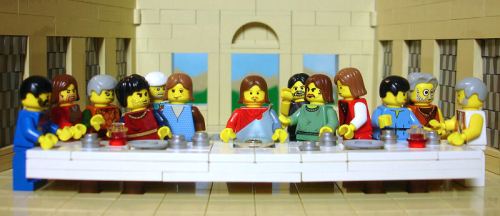By Michelle Albert
 A recent article on Slate raises the question of a possible connection between the Last Supper and Passover, dredging up a long-standing source for argument and speculation.
A recent article on Slate raises the question of a possible connection between the Last Supper and Passover, dredging up a long-standing source for argument and speculation.
On the surface, and indeed to many Jews and Christians, the Last Supper seems to have been a seder. It is generally acknowledged that Jesus was Jewish; in fact, early Christians had to be Jews before they could be Christian. At the Last Supper, Jesus and his disciples said blessings over the bread and wine and reclined as they ate. (Though that they ate bread, not matzah, is one mark against the correlation). Three of the four gospels, those of Matthew, Mark and Luke, state that the Last Supper happened after the start of Passover.
We know that the Last Supper and the resurrection happened around Passover – the proximity of Passover and Easter attests to that. But there is plenty of debate whether the Last Supper happened either before Passover started, or on the first night. The fourth gospel, that of John, dates the day before Passover (when the Jews were preparing for Passover) as the time of the crucifixion. And Jesus’ actions, though reminiscent of Passover tradition, also match up with what was done at most Jewish tables at the time. (And remember: bread, not matzah).
An article in the Biblical Archaeology Review suggests that the gospels of Matthew, Mark and Luke cannot be treated as reliable, independent sources. The three gospels are referred to as the synoptic gospels, meaning that they are best studied together. The article claims the synoptic gospels are merely the same story written three times.
However, it seems scholars must tread carefully when it comes to analyzing any of the four gospels. As the first gospel was written 40 years after Jesus’ death, and the Bible was written over 300 years, and was then rewritten multiple times, their status as reliable historical record is open to speculation. But, as these accounts are the most complete records of the times, they are therefore useful in establishing context.
The Biblical Archaeology Review states that the Last Supper was not a seder; Slate is unable to draw a conclusion. Arguments for and against the correlation between the Last Supper and Passover are persuasive. It seems more discussion and research are necessary. If scholars can find proof that Jews were actually in Egypt, then perhaps proof of the origin of the Last Supper is still waiting to be found.
Related reading:
NPR has an article on the connection between depictions of the Last Supper meal and how portion size has increased over the years. Yes, this is as weird as it sounds. (But then, as dinner portions in paintings of the Last Supper got bigger, wouldn’t waistlines expand as well? We want to see some rotund disciples!)

4 thoughts on “Seders, and the Last Supper, and Jesus! Oh, My!”
wow… really nice blog…. wonderfully written….Outstanding….
i like it….
Balance of lines…. really awsum…
visit mine… & plz plz plz put your comments…. Thank you…
i’ll be in touch
So much info – never ending learning experience.
yae, this is the excellent blog i like it too thanks john
As a part of Christian theology the Last Supper was concocted to appeal and entice early Christians including gentiles. While creating Christian narrative the connection to any part of traditional Judaism was the least concern of story tellers.